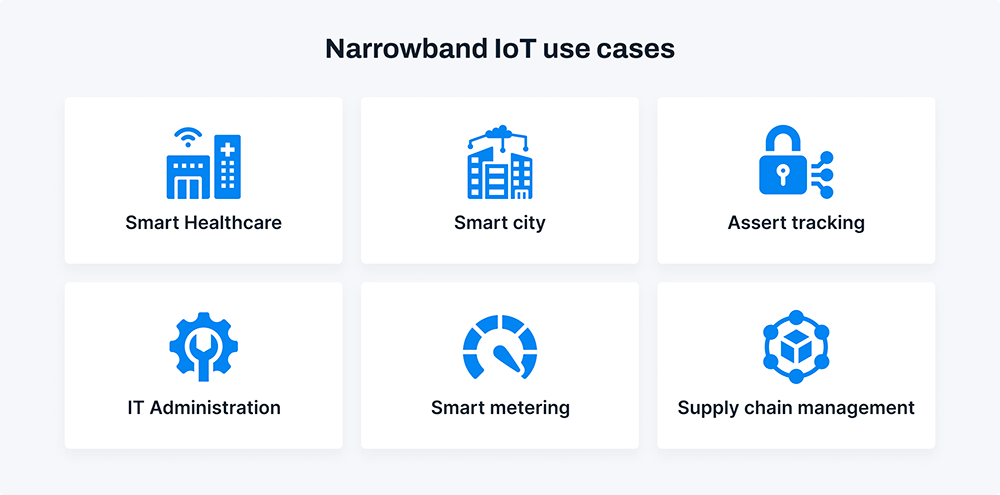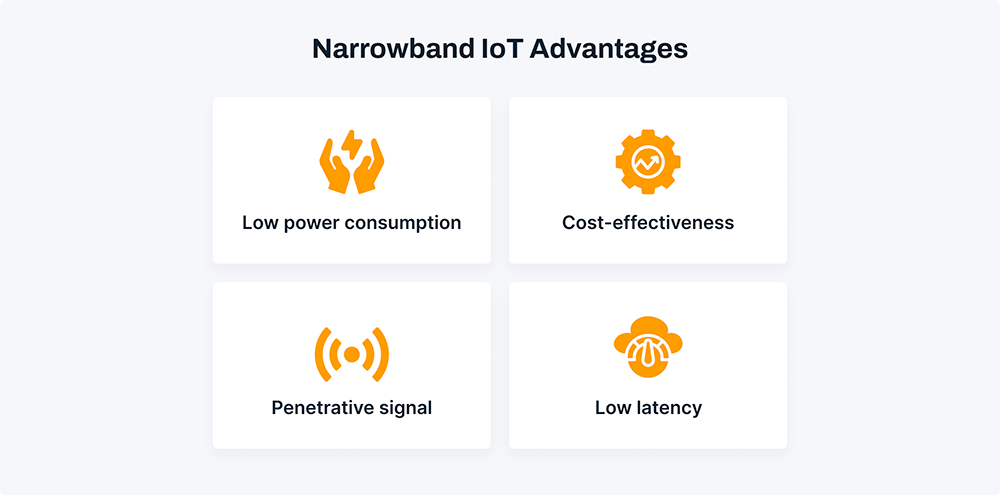Narrowband IoT: Use Cases, Security, Advantages & Challenges
March 15, 2024Narrowband IoT (NB-IoT) is like a superhero in the realm of the Internet of Things (IoT), bringing a wave of transformation with its specialized powers. Imagine it as a tailor crafting communication capes for a diverse group of low-power devices, connecting them seamlessly. By utilizing the strength of existing cellular networks, NB-IoT swoops in to make deploying IoT solutions a breeze, saving the day with efficiency, cost-effectiveness, and widespread adoption across different industries.
With its super abilities like extended coverage, deep penetration, and low power consumption, NB-IoT becomes the hero for applications requiring steadfast long-range connectivity, even in the face of tough challenges. Join us on this adventure as we delve into the fundamentals of NB-IoT, exploring its key features, real-world applications, and the shield of security it provides. Witness firsthand how Narrowband IoT holds the promise to revolutionize innovation and connectivity in the exciting world of IoT!
What is narrowband IoT?
The upcoming wave of IoT devices is poised to revolutionize communication through NB-IoT, a cutting-edge mobile communications standard. NB-IoT builds upon the existing LTE infrastructure, tapping into previously untapped frequency bands to enable seamless connectivity. Embraced across Asia, Europe, and North America, NB-IoT promises enhanced efficiency and expanded capabilities for IoT networks.
The affordable pricing of NB-IoT stems from its effectiveness within the wireless carrier sector. NB-IoT facilitates the transmission of telemetry and control data at minimal volumes, operating within narrow frequency bands to optimize energy usage. Moreover, its ability to penetrate building structures effectively ensures reliable connectivity in various environments.
NB-IoT opens doors to IoT applications previously hindered by cost or technical constraints. It's ideal for scenarios requiring low data rates or stationary device networks, offering flexibility, security, and cost-effectiveness. As a result, NB-IoT emerges as a compelling choice across various industries.
Narrowband IoT use cases

Smart healthcare
NB-IoT holds the potential to transform healthcare by enabling seamless connectivity among medical devices and collecting data from wearables and implanted sensors. Its low-power and long-distance transmission capabilities are well-suited for intermittent patient data transmission, enhancing remote patient monitoring and overall care quality during treatment.
The NB-IoT-enabled out-of-bed system prioritizes patient safety, particularly for those prone to falls, without compromising their freedom of movement. Equipped with sensors, the bed detects when a patient sits up at night, triggering automatic lighting. If the patient exits the bed, nursing staff are promptly alerted, allowing swift intervention to prevent accidents or falls.
Smart city
As urbanization continues its rapid growth, with a projected 60% of the global population expected to reside in cities by 2030, the strain on infrastructure escalates. In response to this mounting pressure, urban planners are turning to innovative solutions, with smart cities at the forefront. These technologically advanced urban centers not only offer solutions for critical urban challenges like water supply and waste management but also prioritize smart city security.
Imagine a scenario where a smart city's security system detects unauthorized access and immediately alerts law enforcement, enhancing public safety. Additionally, smart surveillance systems can monitor public spaces for potential threats, providing real-time alerts to authorities. By integrating advanced technologies like NB-IoT, smart cities can optimize security measures, ensuring a safe and resilient urban environment for all residents while also enhancing operational efficiency and productivity across various sectors.
Asset tracking
NB-IoT technology provides robust and secure communication compared to unlicensed options like WiFi or Bluetooth, operating within the licensed cellular spectrum. This ensures network data security, impervious to external interference. With extended battery life, it's ideal for manufacturing applications requiring prolonged device usage.
NB-IoT technology proves invaluable for tracking assets in cold storage warehouses, production lines, and shipments. While it may not be ideal for mobile assets due to intermittent messaging, it's highly effective and cost-efficient for monitoring static assets.
IT administration
Ensuring the security of NB-IoT devices is paramount for IT administrators, requiring rigorous encryption measures to thwart potential cyber threats. Each device must be encrypted on the network to safeguard against unauthorized access and data breaches. Additionally, IT administrators should strategically deploy NB-IoT devices in locations that require extended battery support but remain stationary, optimizing their functionality and longevity. This proactive approach enhances device security and ensures optimal performance and reliability in various operational environments.
Smart metering
Utilizing NB-IoT technology offers an excellent solution for connecting utility meters, such as electricity, water, or gas meters. Its low data requirements and robust coverage make it well-suited for these devices, often situated in building basements. Moreover, NB-IoT enables automated transmissions, providing consumers with transparent and comprehensive insights into their current consumption patterns.
Smart metering, enabled by NB-IoT, identifies energy-consuming devices in homes and advises consumers on cost-saving measures. This technology empowers companies to enhance energy management, cut expenses, and promote resource conservation. Additionally, NB-IoT facilitates the integration of renewable energy sources like solar and hydropower into the grid, enabling dynamic pricing based on real-time data.
Also, take a look at our life smart metering dashboard for a better understanding of how metering works.
Supply chain management
The future of delivery is undergoing a transformative shift with NB-IoT technology. Retail and logistics demand solutions with low latency, high reliability, and minimal power consumption. With its worldwide coverage, NB-IoT is poised to revolutionize operations, enabling tasks like inventory tracking and customer data management across large areas and multiple stores.
In addition, NB-IoT can aid in tasks like monitoring temperature levels for perishable goods and optimizing store layouts for maximum return on investment. Unlike traditional wide area networks (WANs), which can be costly to install and challenging to integrate with existing infrastructure, NB-IoT offers a cost-effective solution. It utilizes small cells with low power consumption, making it a practical choice for various networking needs.
Narrowband IoT security
Ensuring security in Narrowband IoT is like fortifying a castle to protect the treasures of data transmitted through magical low-power wide-area networks. As IoT devices become more prevalent across different realms, it becomes crucial to set up strong defenses against lurking cyber threats.
Think of encryption as casting a powerful spell of protection over the data. Spells like the Advanced Encryption Standard (AES) act as shields, keeping data safe during its journey and warding off any unwelcome intruders. Just like safeguarding precious artifacts, managing encryption keys securely is key to ensuring they stay out of the wrong hands.
Authentication is like having a secret handshake to enter a hidden chamber. By using techniques like mutual authentication, devices and network servers can establish trust, ensuring only trusted companions gain access to sensitive information while keeping imposters at bay.
Implementing a secure boot mechanism is akin to placing magical wards around devices to ward off dark forces. By checking the integrity of device firmware during startup, organizations can prevent unauthorized tampering and maintain the sanctity of their IoT realm.
Regular security audits are like sending out scouts to uncover hidden dangers in the kingdom. By diligently assessing vulnerabilities and swiftly addressing any weaknesses found, organizations can fortify their IoT stronghold and thwart potential cyber attacks before they strike.
Advantages & challenges of NB-IoT
Narrowband IoT advantages

Low power consumption
IoT technology has flourished in areas where NB-IoT offers efficient, low-power wireless capabilities tailored to the challenges of IoT applications. Carriers tout its ability to prolong battery life, but optimal device performance requires meticulous antenna integration. Strong power capabilities and seamless access to WLAN frequencies are essential for IoT devices. Yet, for widespread acceptance, these devices must connect reliably even in areas with weaker signals.
Cost-effectiveness
NB-IoT modules are simpler and cheaper to produce than 4G LTE modules and also offer significant cost savings in cellular data usage. Their low data consumption translates to reduced cellular data expenses, making NB-IoT devices a cost-effective solution for a wide range of applications.
Penetrative signal
NB-IoT is engineered to penetrate barriers like brick walls, making it ideal for devices tucked away in hard-to-reach spots. With its low bitrate frequency, NB-IoT provides an extended link budget, enabling connectivity in places where traditional cellular signals struggle to reach. This means you can stay connected through devices located in underground tunnels, remote rural areas, or even deep within buildings.
Low latency
IoT devices often operate in demanding environments where reliable data transmission is crucial. Recent trials indicate that NB-IoT can achieve sub-10 latency even in underground settings, ensuring efficient performance for live monitoring systems. This technology minimizes packet loss and enhances device functionality by reducing lag time, resulting in smoother data streaming and improved overall performance.
Narrowband IoT challenges
Data transmission
NB-IoT boasts a data upload rate of approximately 20 KBPS, notably lower than LTE-M's 1MBPS. While this enhances power efficiency, it constrains its applicability for tasks demanding high data transfer speeds, like video calls or voice support.
Roaming
NB-IoT is still a relatively new technology and isn’t universally available across all countries. The rollout of NB-IoT networks depends on the readiness of Mobile Network Operators and the establishment of roaming agreements. These factors may temporarily restrict the technology's accessibility in certain regions. Additionally, regulatory approvals and spectrum allocation processes can influence the pace of NB-IoT deployment in different countries.
Device mobility
NB-IoT devices consume more power when moving away from cell towers, reducing efficiency for highly mobile devices like wearables and GPS trackers. This limitation arises due to the technology's focus on stationary or slow-moving applications, making it less suitable for scenarios requiring constant connectivity while on the move.
Conclusion
Narrowband IoT (NB-IoT) holds immense potential across various industries due to its efficient, low-power connectivity and wide coverage capabilities. From smart cities to healthcare and logistics, NB-IoT offers numerous use cases, enhancing efficiency and enabling innovative solutions. However, challenges such as security concerns and limited data rates need to be addressed for widespread adoption. Despite these challenges, NB-IoT remains a promising technology poised to drive the next wave of IoT innovation.
Do you have issues with your IoT device's connectivity? Contact us, and KaaIoT experts will help your IoT connectivity.
FAQ
Is narrowband IoT compatible with 5G?
NB-IoT is not 5G but is designed to be compatible with 5G. It operates within the same sub-6 GHz frequency band as 4G LTE and is tailored specifically for IoT applications. NB-IoT and LTE-M have evolved to become integral components of the 5G, including their integration into 5G IoT modules.
Is Cat-M2 better than NB-IoT?
Cat M2 offers higher data rates and better mobility support compared to NB-IoT, making it suitable for applications like mobile tracking. However, NB-IoT excels in power efficiency and coverage, ideal for stationary or low-data-rate IoT deployments. Choose based on specific use case needs.
Does NB-IoT use LTE?
NB-IoT utilizes LTE technology, specifically within the LTE spectrum, to enable low-power, wide-area connectivity for IoT devices.
Do you need a SIM card for NB-IoT?
NB-IoT devices typically require a SIM card to connect to the cellular network and transmit data efficiently.
Does NB-IoT support SMS?
NB-IoT does not support SMS communication. It is primarily designed for low-power, narrowband IoT applications focused on data transmission rather than text messaging.
